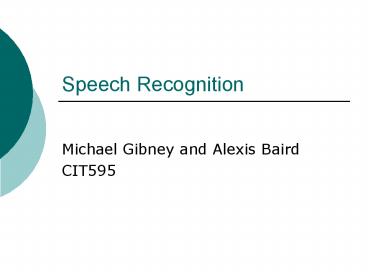Speech Recognition PowerPoint PPT Presentation
1 / 18
Title: Speech Recognition
1
Speech Recognition
- Michael Gibney and Alexis Baird
- CIT595
2
Speech Recognition Applications
- Automation, translation, dictation and
transcription, medical, and military uses - In any situation where keyed input is impractical
or impossible (as in military aircraft cockpits,
over-the-phone computer interaction, or in cases
where the user is physically handicapped), speech
recognition technology can overcome obstacles by
providing the possibility of a voice user
interface.
3
Speech Recognition Overview
- Acoustic Signal
- Phonemes
- Words
- Sentences
4
Acoustic Signal
- Acoustic signal is sliced up by given time
units and features are automatically marked - Calculate probability that a set of signals
produced a given phoneme
5
Phonemes What are phonemes?
- foxes ? f?ks?z
- tough ? t?f
- Not necessarily one-to-one correspondence with
written letters - Each phoneme has a unique set of features that
can be extracted from its acoustic realization
6
Phonemes
- Why is identifying phonemes hard?
- No one has unique set of phonemes gender
differences, dialectical variation, etc. - Pin, pen, legs, bad, caught
- Allophonic variation pot spot, top
7
Acoustic Signal to Phonemes
- Compression/Rarefaction of air
- Diaphragm(microphone)-gtanalog
- A-gtD conversion (sampling quanitzation)
- Sample (for speech recognition) usually stored as
an int (8- or 16-bit) - Sample/Quantization tradeoff frequency accuracy
(Nyquist frequency)? Amplitude accuracy (bit
depth)?
8
Data Representation
- What information is considered important? (varies
for different applications fixed/float DSP, bit
depth, etc.) - Amplitude/time-gtFreq-Amp/Time (Spectrogram) (can
be read back into sound! In theory, the
digitized wave form should be able to be read
directly. All the information is there, and
despite the variation of contexts, frequency
combinations are clearly recognizable (to
humans!) as being a human voice!) - Ampl. wave decomposition can be interpreted into
phonemes (highly contextual! e.g. different
voices, accents, noise, sentence context, etc.)
9
Phonemes to Words
- Why is it hard to identify words from phonemes?
- set your, what you, find him, left me
- Simple Conditional Probability Algorithm
- w argmax P(wO) P(Ow)P(w) P(Ow)P(w)
- w ? V P(O)
- O o1o2o3on ? sequence of observations
- w ? some word in the universe V
10
Phonemes to Words II
- Weighted Automoton states corresponding to
single phoneme and set of transition
probabilities between states ? pronunciation
network for each potential word - What does this remind us of?
- Forward Algorithm given input of a pronunciation
network for each possible word and an observed
sequence spectral input slices, we want the
probabilities of possible words corresponding to
the observed sequence - forwardt, j is the probability of being in
state j after seeing the first t observations
given the automaton ? - forwardt, j P(o1o2o3ot, qt j ?) P(w)
- Forward algorithm is applied to each word and the
word with the greatest probability is selected
11
Phonemes to Word III
- Forward algorithm makes a few simplifications
- Assumes that input is a sequence of symbols
rather than slices of an acoustic signal - Assumes that input symbols have an exact
one-to-one correspondence to states - Solution? Hidden Markov Models
12
Hidden Markov Models
- Extension of simple state machine idea
- Adds a sequence of observations which dont
uniquely determine the states but have a
corresponding set of observation likelihoods - Observation likelihoods are the probability of a
given observation being generated from a given
state
13
Words to Sentences
- Why do we care about sentence-level?
- W argmax P(WO) P(OW) P(W)
- P(O)
- P(OW) P(W)
- P(W) ? prior probability
- P(OW) ?observation likelihood
14
Prior Probability P(W)
- Probability of a given sequence of words
- Use n-gram models
- Bigrams Example find relative frequency of pairs
of words such as want to - Requires a huge corpus (collection of data)
15
Oberservation Likelihood P(OW)
- Many different types of algorithms
- Use Hidden Markov Models (find the probability of
a sequence of phonemes given the entire sentence) - Viterbi and A Algorithms compute the
probability of an observation sequence given each
sentence AND return the most-likely sentence
16
Viterbi Algorithm
- Find the best state sequence (qq1q2qr) given
an observation sequence (o) and a model/state
graph (?) - A matrix in which each cell contains the
probability of the best path to that cell the
y-axis is all the words in the lexicon the
x-axis is a sequence of observed phonemes - Viterbit, imax P(q1q2qti, o1o2ot?)
17
Obstacles in Speech Recognition
- John hit Mary. John hid Mary.
- Dialectical variation
- Noise interference
- Fast speech or hyper-articulated speech
18
Other Methods in SR
- Discourse level ? context of the surrounding
speech is used to predict future words - Training on domain specific corporaie. if the
speech recognition system is for an airline, use
a context-specific corpus

